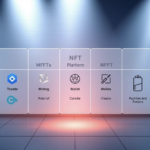Now Reading: Ethereum Staking: A Step-by-Step Guide for Beginners
- 01
Ethereum Staking: A Step-by-Step Guide for Beginners
Ethereum Staking: A Step-by-Step Guide for Beginners
Participating in blockchain networks has evolved into a hands-on way to earn while contributing to digital ecosystems. The shift to Proof-of-Stake (PoS) has made it possible for users to support transaction validation without expensive hardware. By locking up crypto assets, individuals can now play a direct role in maintaining network security and efficiency.

This process involves activating specialized nodes called validators. These systems verify transactions and propose new blocks, ensuring the chain remains decentralized and trustworthy. In return for their efforts, participants receive regular rewards, creating a steady income stream tied to their involvement.
Newcomers often wonder how to get started safely. This guide breaks down everything from initial setup to managing returns. You’ll learn how to navigate risks, choose reliable platforms, and maximize your contributions to the network’s growth.
Key Takeaways
- Proof-of-Stake replaces energy-intensive mining with validator-based consensus.
- Locking crypto assets activates validators that secure the network.
- Active participation earns regular rewards proportional to your stake.
- Validators must maintain uptime to avoid penalties or reduced payouts.
- Funds remain locked until specific network conditions are met for withdrawal.
Understanding Ethereum and Its Transition to Proof-of-Stake
Blockchain technology took a leap forward with the arrival of a platform designed for programmable agreements. Launched in 2015, this system introduced tools that let developers build apps without centralized control. Its founder, Vitalik Buterin, envisioned a decentralized ecosystem where code could automate trust.
Overview of Ethereum’s Evolution
Originally relying on Proof-of-Work (PoW), the network faced challenges like high energy costs and slow processing. This method required massive computing power, limiting accessibility. However, its ability to host smart contracts and decentralized apps (dApps) fueled rapid growth. These features became the backbone of modern DeFi platforms.
Benefits of Moving from PoW to PoS
The shift to Proof-of-Stake (PoS) slashed energy use by 99%, aligning with global sustainability goals. Instead of competing to solve puzzles, participants now secure the chain by locking assets. This staking mechanics approach boosts scalability, enabling faster transactions. It also lowers barriers to entry, letting more users contribute to consensus processes.
With PoS, ETH holders can actively maintain the network while earning rewards. The upgrade ensures the system remains adaptable to future demands, balancing security and efficiency.
What is Ethereum Staking?
Modern networks rely on contributors who secure transactions using locked digital assets. This method replaces energy-heavy systems with economic incentives, letting users prove their dedication to network integrity.

Basic Concepts and Terminology
Participants lock crypto holdings to activate validator nodes. These systems check transactions through attestations — votes confirming block accuracy. The network reaches consensus when most validators agree on transaction validity.
Malicious actions trigger slashing, where offenders lose part of their locked funds. This penalty protects against attacks, ensuring honest validator operations dominate.
Role of Validators in the Network
Validators propose new blocks and verify others’ work. They must stay online consistently to avoid penalties. Unlike miners, they don’t need specialized gear — just reliable internet and staked assets.
Rewards depend on participation rates and total locked value. Higher engagement boosts earnings, creating a fair system tied to contribution levels.
Your Guide to Ethereum staking
Choosing how to support blockchain operations involves balancing convenience with security. Two primary paths exist: custodial platforms and self-managed solutions. Each approach affects your control over assets and potential earnings.
Custodial Platforms: Simplicity vs. Centralization
Centralized exchanges let users earn yield without managing private keys. These staking services handle technical requirements, making them ideal for newcomers. However, they pool large amounts of ETH, creating single points vulnerable to outages or attacks.
While convenient, this consolidation contradicts blockchain’s decentralized ethos. Major providers control thousands of validators, increasing systemic risks. Learning self-custody methods helps maintain network health long-term.
Evaluating Earnings and Vulnerabilities
Non-custodial options grant full asset control but require technical skills. Rewards often match custodial rates, though fees vary. Independent stakers avoid third-party risks but face penalties for validator downtime.
Centralized platforms may offer slightly lower returns due to operational costs. Both approaches lock ETH temporarily, but custodial solutions sometimes impose additional withdrawal delays. Weigh these factors against your security priorities and technical confidence.
Step-by-Step Process for Staking ETH
Initiating participation in network validation requires precise technical steps. Users must generate cryptographic keys and interact with specialized agreements to begin earning rewards. This staking process ensures network integrity while maintaining user control over assets.

Depositing ETH into the Deposit Contract
Start by creating validator keys using trusted software. These include a signing key for transaction verification and withdrawal credentials for fund recovery. Next, sign a deposit message with your validator’s private key. This message contains your public identifier and the address where rewards will accumulate.
Transfer at least 32 ETH alongside this signed data to the network’s deposit address. The smart contract automatically routes these funds to the consensus layer, locking them until specific exit conditions are met. Double-check all details before confirming the transaction.
Activation and Setting Up a Validator
After the deposit, your request enters an activation queue. Wait times vary based on how many others are joining the network simultaneously. Once activated, your validator node must remain online to verify transactions and propose blocks.
Use monitoring tools to track performance and avoid penalties. Maintain stable internet connectivity and update software regularly. Successful participation earns rewards proportional to your contribution and the network’s overall activity levels.
Exploring Staking Methods: Solo, Pools, and Services
Contributing to network security now accommodates various user preferences, from hands-on control to managed solutions. Three distinct approaches let participants engage based on their technical skills, available resources, and desired involvement levels.
Requirements for Solo Staking
Solo staking requires a minimum of 32 ETH and full responsibility for running a validator node. Users need advanced technical knowledge to configure software, maintain hardware, and ensure 24/7 uptime. Even brief outages can trigger penalties, making stable internet essential.
This method offers complete oversight of rewards and operations. However, it demands constant monitoring and troubleshooting skills. Those who succeed gain direct influence over network integrity without sharing earnings.
Advantages of Staking Pools and Third-Party Services
For smaller ETH amounts, pooled options let users combine resources. Participants receive rewards proportional to their stake, bypassing the 32 ETH threshold. These groups handle validator setup but reduce individual control.
Third-party staking services simplify participation further. They manage nodes entirely, allowing users to earn yields passively. While convenient, research providers thoroughly to avoid hidden fees or security risks.
- Solo: Full control, high technical demands
- Pools: Shared costs, lower entry barriers
- Services: Hands-off approach, potential centralization
Harnessing Smart Contracts and the Deposit System
Automated agreements form the backbone of secure asset management in decentralized systems. These self-executing tools enforce rules without third parties, creating trust through code. For participants, this means direct control over funds while contributing to network operations.

How Smart Contracts Secure Your Stake
Validator operations rely on a dual-key setup. The signing key validates transactions and block proposals, while withdrawal credentials determine where rewards go. Once set, withdrawal addresses can’t be altered, ensuring only the original owner accesses funds.
The deposit contract acts as a bridge between layers. It moves ETH from the execution layer to the consensus layer, locking it until exit conditions are met. This design prevents unauthorized transfers during validation periods.
Understanding Transaction Fees and Deposits
Depositing assets involves gas fees for processing transactions. Costs vary based on network congestion but typically remain low. Key factors influencing fees include:
- Data complexity in deposit messages
- Current gas prices on the execution layer
- Validator activation queue length
Consensus mechanisms ensure all nodes agree on deposit validity. This protocol prevents double-spending and maintains ledger accuracy. By combining automated contracts with cryptographic proofs, the system achieves security without centralized oversight.
Validator Roles and Block Production Explained
Network integrity relies on participants who verify transactions and maintain ledger accuracy. Validators act as digital gatekeepers, ensuring every block added to the chain meets strict protocol standards. Their work forms the foundation of decentralized trust.
How Validators Propose and Attest to Blocks
Selected at random, validators take turns proposing blocks containing pending transactions. This system prevents dominance by any single participant. When chosen, a validator bundles transactions into a new block and broadcasts it to others for review.
Other validators then attest to the block’s validity through cryptographic votes. Consensus occurs when two-thirds agree the data is correct. This dual-layered approach balances speed with security, as multiple checks occur before finalization.
Key responsibilities include:
- Maintaining 24/7 node availability
- Verifying transaction authenticity
- Reporting malicious activity to trigger penalties
Validators earn rewards for honest participation but risk losing funds for dishonest acts. The randomization process ensures equal opportunities, while the 32 ETH requirement discourages careless operations. This structure keeps the network resilient against attacks and errors.
Managing Risks: Lock-Up Periods, Slashing, and Fees
Engaging with blockchain validation involves balancing potential rewards with critical risks. Lock-up periods restrict access to staked ETH, meaning funds remain unavailable until specific network conditions are met. This lack of liquidity requires careful planning, especially for those needing quick access to assets.
Identifying and Minimizing Potential Penalties
Validators face penalties for actions that disrupt the consensus process. Severe violations like malicious behavior or prolonged downtime trigger slashing, which permanently removes a portion of staked ETH. Minor errors, such as incorrect voting, reduce rewards without affecting the principal stake.
To avoid penalties:
- Maintain consistent validator uptime
- Update software to prevent compatibility issues
- Monitor network requirements regularly
Transaction fees and activation delays add complexity. Deposits take time to process, and exit queues may prolong withdrawals during high demand. Factor these variables into your strategy to optimize returns while safeguarding assets.
FAQ
How does the transition to proof-of-stake improve blockchain efficiency?
The shift reduces energy consumption by over 99% compared to proof-of-work. It also lowers barriers for participation, allowing more users to secure the network and earn rewards without specialized hardware.
What technical requirements apply to solo validators?
Running a validator node demands 32 ETH, reliable internet, and dedicated hardware meeting consensus layer specifications. Participants must maintain uptime to avoid penalties like slashing or missed rewards.
Can small investors participate without holding 32 ETH?
Yes. Liquid staking protocols and pooled services let users contribute smaller amounts. These platforms combine resources to activate validator nodes while distributing rewards proportionally.
How do smart contracts protect deposited funds?
Automated code enforces staking rules transparently, eliminating human intervention. Deposits remain locked until withdrawals are enabled, with penalties applied automatically for protocol violations.
What determines validator rewards?
Earnings depend on network activity, total ETH staked, and uptime. Validators proposing blocks receive higher payouts than those merely attesting, with average annual returns currently between 3-5%.
Are there risks beyond market volatility?
Yes. Slashing penalties remove funds for malicious actions, while offline nodes lose incremental rewards. Third-party services also carry smart contract risks or custodial exposure.
How long does validator activation take?
After depositing 32 ETH into the contract, nodes enter a queue. Activation typically occurs within days, depending on network demand and the number of pending validators.
Can staked ETH be used elsewhere during lock-up?
Liquid staking tokens (LSTs) like stETH enable trading or lending while earning rewards. However, direct staking through the deposit contract requires funds to remain locked until withdrawals.













